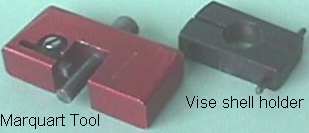Looking at the numbers.
Looking at the numbers.
The coefficient of thermal expansion is:
Aluminum 1.37e-5 in/(in * deg F)
Tungsten Carbide 3.90e-6 in/(in * deg F)
On my Marquart tool, the distance from the center of the mandrel to where the 1/8" cutting tool bit is mounted is 0.5 inches.
To calculate the amount of expansion, the equation is:
dL = L0 * dT * alpha
dL is the change in length
L0 is the original length
alpha is the coefficient of thermal expansion
Assuming an initial temperature of 60 deg F and a final temperature of 120 deg F which is warm to the touch, then the expansion is:
dL = 0.5 * (120-60) * 1.37e-5
dL = 0.000411
The carbide mandrel's radial expansion is:
dL = 0.1215 * (120-60) * 3.90e-6
dL = 0.0000284
Since the mandrel moves the brass closer to the cutting tool and the aluminum moves the cutting tool away from the brass the actual change in distance is the aluminum expansion minus the carbide expansion.
The change if cutting depth for a 60 degree F change in temperature is 0.000383 inches.
I warm my Marquart in my pocket before I start neck turning and turn at a slow rate and the Marquart stays at about the same 90 deg F temperature as I neck turn. The distances are probably different on other neck turning tools but the procedure is the same.
Good Hunting... from Varmint Al





